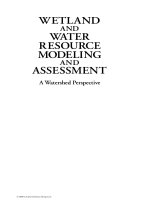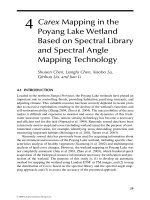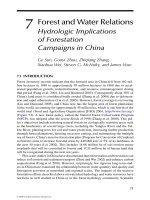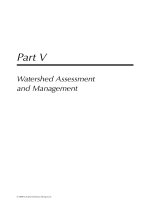A New Ecology - Systems Perspective - Chapter 1 pot
Bạn đang xem bản rút gọn của tài liệu. Xem và tải ngay bản đầy đủ của tài liệu tại đây (131.53 KB, 6 trang )
1
Introduction: A new ecology is
needed
1.1 ENVIRONMENTAL MANAGEMENT HAS CHANGED
The political agenda imposed on ecologists and environmental managers has changed
since the early 1990s. Since the Rio Declaration and Agenda 21 the focus has been on sus-
tainability, which inevitably has made ecosystem functioning a core issue. Sustainability
Development is, according to the Rio Declaration, defined as follows: “development that
meets the needs of the present without compromising the ability of future generations to
meet their own needs.” And, the contrasting parties are invited to, “act in a way that is eco-
nomically profitable, socially acceptable, and environmentally compatible.” Already the
Rio Declaration emphasized the importance of ecosystems in Principle 7: States shall
cooperate in a spirit of global partnership to conserve, protect, and restore the health and
integrity of the Earth’s ecosystems.
In view of the different contributions to global environmental degradation, states have
common but differentiated responsibilities. The developed countries acknowledge the
responsibility that they bear in the international pursuit of sustainable development in
view of the pressures their societies place on the global environment and of the tech-
nologies and financial resources they command.
The Convention of Biodiversity adopted, in 2000, 12 principles—called the Ecosystem
Approach—that placed the ecosystem concept even more centrally into environmental
management considerations. It is particularly clear from the last 10 of the 12 principles:
(1) The objectives of management of land, water, and living resources are a matter of
societal choice.
(2) Management should be decentralized to the lowest appropriate level.
(3) Ecosystem managers should consider the effects (actual or potential) of their activities
on adjacent and other ecosystems.
(4) Recognizing potential gains from management, there is usually a need to understand
and manage the ecosystem in an economic context. Any such ecosystem-management
program should:
a. Reduce those market distortions that adversely affect biological diversity.
b. Align incentives to promote biodiversity conservation and sustainable use.
c. Internalize costs and benefits in the given ecosystem to the extent feasible.
1
Else_SP-Jorgensen_ch001.qxd 3/31/2007 08:36 Page 1
2
A New Ecology: Systems Perspective
(5) Conservation of ecosystem structure and functioning, in order to maintain ecosystem
services, should be a priority target of the ecosystem approach.
(6) Ecosystems must be managed within the limits of their functioning.
(7) The ecosystem approach should be undertaken at the appropriate spatial and
temporal scales.
(8) Recognizing the varying temporal scales and lag-effects that characterize ecosystem
processes, objectives for ecosystem management should be set for the long term.
(9) Management must recognize that change is inevitable.
(10) The ecosystem approach should seek the appropriate balance between, and integra-
tion of, conservation and use of biological diversity.
(11) The ecosystem approach should consider all forms of relevant information, includ-
ing scientific and indigenous and local knowledge, innovations, and practices.
(12) The ecosystem approach should involve all relevant sectors of society and scientific
disciplines.
Also in the book Ecosystems and Human Well-being, a Report of the Conceptual
Framework Working Group of the Millennium Ecosystem Assessment from 2003, ecosys-
tems are the core topic. In Chapter 2 of the book, it is emphasized that: an assessment of
the condition of ecosystems, the provision of services, and their relation to human well-
being requires an integrated approach. This enables a decision process to determine
which service or set of services is valued most highly and how to develop approaches to
maintain services by managing the system sustainably. Ecosystem services are the bene-
fits people obtain from ecosystems. These include provisioning services such a food and
water; regulating services such as flood and disease control; cultural services such as
spiritual, recreational, and cultural benefits; and supporting services such as nutrient
cycling, which maintain the conditions for life on Earth.
Today, environmental managers have realized that maintenance of ecosystem structure
and functioning (see Principle 5 above) by an integrated approach is a prerequisite for a
successful environmental management strategy, which is able to optimize the ecosystem
services for the benefit of mankind and nature. Another question is whether we have suf-
ficient knowledge in ecology and systems ecology today to give the needed information
about ecosystem structure, function, and response to disturbance to scientifically pursue
the presented environmental management strategy and ecosystem sustainability. In any
way, the political demands provide a daunting challenge for ecosystem ecology.
1.2 ECOLOGY IS CHANGING
As a consequence of the changing paradigm direction of environmental management, we
need to focus on ecosystem ecology. An ecosystem is according to the Millennium
Report (2003) defined as “a dynamic complex of plants, animals and microorganism
communities and the nonliving environment, interacting as a functional unit. Humans are
an integral part of ecosystems.”
A well-defined ecosystem has strong interactions among its components and weak
interactions across its boundaries. A useful ecosystem boundary is the place where a
Else_SP-Jorgensen_ch001.qxd 3/31/2007 08:36 Page 2
number of discontinuities coincide for instance in the distribution of organism, soil type,
drainage basin or depth in a water body. At a larger scale, regional and even globally
distributed ecosystems can be evaluated based on a commonality of basic structural units.
Three questions are fundamental to pursue for ecosystem-based environmental man-
agement:
I: What are the underlying ecosystem properties that can explain their response to
perturbations and human interventions?
II: Are we able to formulate at least building blocks of an ecosystem theory in the form
of useful propositions about processes and properties? We prefer the word “proposi-
tions” and not laws because ecosystem dynamics are so complex that universal laws
give way to contextual propensities. The propositions capture these general tendencies
of ecosystem properties and processes that can be applied to understand the very nature
of ecosystems, including their response to human impacts.
III: Is the ecosystem theory that we can formulate to understand ecosystem properties
sufficiently developed to be able to explain ecological observations with practical
application for environmental management?
The scope of the book is an attempt to answer these questions to the extent that is
currently possible. The authors of this book have realized that an ecosystem theory is a pre-
requisite for wider application of ecological sciences in environmental management because
theory provides a strong guide for environmental management and resource conservation.
1.3 BOOK OUTLINE
Chapters 2–7 present the fundamental properties that explain typical ecosystem
processes under “normal” growth and development and their responses to disturbance.
These are:
(1) Ecosystems are open systems—open to energy, mass, and information. Openness is
an absolute necessity because the maintenance of ecosystems far from thermody-
namic equilibrium requires an input of energy. This core property is presented in
Chapter 2.
(2) Ecosystems are ontically inaccessible—meaning that due to their enormous complex-
ity it is impossible to accurately predict in all detail ecosystem behavior. It means that
it is more appropriate to discuss the propensity of ecosystems to show a certain pat-
tern or to discuss the direction of responses. This property is presented in Chapter 3.
(3) Ecosystems have directed development—meaning they change progressively to
increase, in particular, feedback and autocatalysis. It is the observed direction of
responses mentioned under point 2. This property is discussed in detail in Chapter 4.
(4) Ecosystems have network connectivity—which gives them new and emergent prop-
erties. The networks have synergistic properties, which are able to explain the
cooperative integration of ecosystem components, which can at least sometimes
yield unexpected system relations. This core property is covered in Chapter 5.
Chapter 1: Introduction
3
Else_SP-Jorgensen_ch001.qxd 3/31/2007 08:36 Page 3
(5) Ecosystems are organized hierarchically—in the sense that we can understand one
level only by understanding interactions with the levels below and above the scale of
focus. Often major changes in one level are leveled out in the higher levels, where
only minor hierarchical organization changes are observed. The properties associated
with the are discussed in great detail by Allen and Starr (1982) in their book
Hierarchy, Perspectives for Ecological Complexity and in the book A Hierarchical
Concept of Ecosystems by O’Neill et al. (1986). The scaling theory and the allomet-
ric principles are rooted in quantification of openness and are, therefore, presented
in Chapter 2. The basic general elements of hierarchy theory are also presented in
this chapter. Further examples of the application of hierarchy theory are presented in
Chapters 3 and 7.
(6) Ecosystems grow and develop—they gain biomass and structure, enlarge their
networks, and increase their information content. We can follow this growth and
development using holistic metrics such as power, eco-exergy, and ascendency,
respectively. For example, incoming solar radiation is first used to cover maintenance
of the ecosystem far from thermodynamic equilibrium and afterwards used to move
the system further from equilibrium, which increases the power, stored eco-exergy,
and ascendency. This growth property is presented in Chapter 6. It is a core property
because it explains how ecosystems develop and even evolve. Many ecosystem
processes are rooted in the competition for the resources that are needed for growth
and can be explained in this light.
(7) Ecosystems have complex response to disturbance—but when we understand prop-
erties of ecosystems such as adaptation, biodiversity, resistance, and connectedness,
to mention a few of the most important properties covered in the book, we can
explain and sometimes predict the responses of ecosystems to disturbances. This part
of the ecosystem dynamics is presented in Chapter 7.
Chapters 2–7 are directed to answer first question above. The second question is
answered throughout these chapters and summarized in Chapter 10, where the presented
ecosystem theory is formulated by use of the seven properties and by formulation of ten
propositions. The two formulations are completely consistent as discussed in this last
chapter of the book.
The last question regarding the applicability of the presented theory to explain eco-
logical observations and to be applied in environmental management is addressed in
Chapters 8 and 9. The application of the theory in environmental management has been
mostly limited to use of ecological indicators for ecosystem health assessment as
described in Chapter 9. The theory has much wider applicability, but the use of ecological
indicators has a direct link to ecosystem theory that facilitates testing the theory. Tests of
the theory according to its applicability in practical environmental management and to
explain ecological observations is crucial for the general acceptance of the ecosystem
theory of course; but it does not exclude that it cannot be improved significantly. On the
contrary, it is expected that the theory will be considerably improved by persistent and
ongoing application because the weaknesses in the present theory will inevitably be
uncovered as the number of case studies increases. Discovery of theoretical weaknesses
4
A New Ecology: Systems Perspective
Else_SP-Jorgensen_ch001.qxd 3/31/2007 08:36 Page 4
will inspire improvements. Therefore, it is less important that the theory has flaws and
lacks important elements than it is that it is sufficiently developed to be directly applied.
We, the authors, are of the opinion that we do have an ecosystem theory today that is
ready to be applied but which also inevitably will be developed significantly during the
next one to two decades due to (hopefully) its wider application.
An ecosystem theory as the one presented in this book may be compared with geo-
graphical maps. We had already 2000 years ago geographical maps that could be applied
to get an overview of where you would find towns, mountains, forests, etc. These maps
were considerably improved and the geographical maps used in the 17th and 18th century
were much more accurate and detailed, although they are of course not comparable with
the satellite-based maps of today. Our ecosystem theory as presented today may be com-
parable with the geographical maps of the 18th century. They are, as the more than 200
years old geographical maps, very useful, but they can be improved considerably when
new methods, additional information, and additional observations are available. It may
take 20 or maybe 50 years before we have the quality of an ecosystem theory comparable
with today’s geographical maps, but the present level of our ecosystem theory is never-
theless suitable for immediate application. Only through this application we will discover
new methods and demand for improvements, both theoretical and practical for science and
management, ultimately leading to a more complete and accurate ecosystem theory.
The most fundamental parts of the presented ecosystem theory, particularly the more
mathematical aspects, are placed in boxes. It makes it on one hand easy to find the theo-
retical elements of the entire ecosystem theory but it also facilitates reading for those
preferring a less mathematical formulation of an ecosystem theory.
Chapter 1: Introduction
5
Else_SP-Jorgensen_ch001.qxd 3/31/2007 08:36 Page 5
This page intentionally left blank









